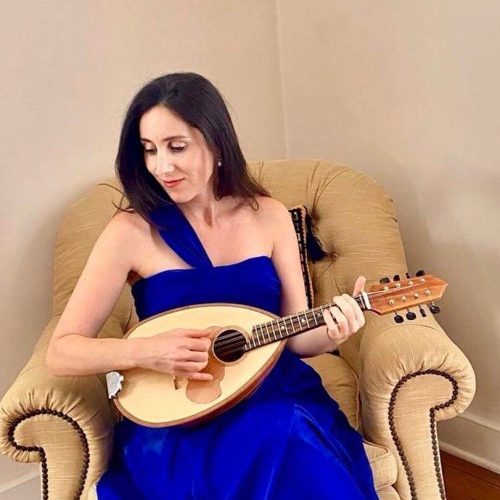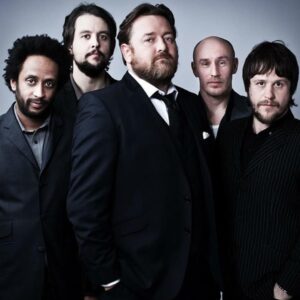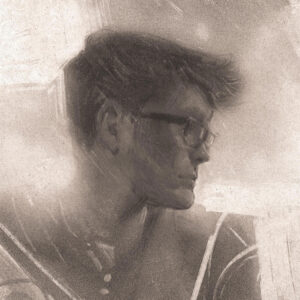Deborah Stokol’s music occupies an interesting niche: the songs she writes are more than just folk songs or retellings of popular fables. Her music seeks to capture an oral tradition of storytelling that is deeply ingrained in the cultures that her music is inspired from. “Stay Mine, Keens the Sailor” from her latest album, Old Wives Tales, keeps this oral tradition alive and well.
The sound of Stokol’s music is traditional, primarily using strings that harken back to the times these stories come from. This is combined by Stokol’s soft and focused voice, and gentle ambiance. “Stay Mine, Keens the Sailor” utilizes quiet guitar, strings, and harpsichord to create a wider sound and helps create the setting for the love-story at the heart of the song. The song speaks of the love between a sailor and his wife. The verse and voice used is beautiful, and the gentle sounds of strings creates an otherworldly but intimate feeling. There’s still some bittersweet notes heard, as the tale is wistful but unresolved. Despite this, the song captures a kind of historic beauty that Stokol is masterful at capturing.
There’s a part in “Stay Mine, Keens the Sailor” where the voice of the song reassures his lover that no matter the distance or time spent apart, poets would be able to write lines detailing the love they share. He hopes his words will keep his face clear in her mind, and that until the end of time, there will be a resonant echo of their love. What Stokol does when she pens her songs is the continuation of these stories. Her songs, her talent as a storyteller and singer, causes these people to live on far past their lives. We hear their struggle, their successes, their passion, and what they leave behind. The line saying that poets will write about their love stands out to me as an affirmation that these stories are being preserved. The human lives once lead in the past continue to live on in our culture, our tales, and our songs.
What is the magic in stories for you?
Ah, there’s so much magic in stories…What a wonderful — and difficult to answer — question. Where to begin…there are all kinds of stories, of course, but I have always loved immersing myself in them, whether through reading, watching a movie, or listening to/playing a song. I think the fact that you can step into a whole other world, maybe one that never even existed, is incredible — that you can escape but also learn but also recognize things from yourself and your life in that world is absolute magic, as in something that’s special and hard to believe is real. The content of the stories, themselves, may not be, but the power they have is very real.
Is it something in the sharing of these stories?
That is a part of it, of course. The idea that someone is telling you a story…as if you are a small child before bed or sitting at a camp fire or in an ancient mead hall is so fun…the thought that someone is singing in your ear or play-acting for you.
But what I love is also that if the story feels engaging, you tend to forget someone is sharing it because you are “in” it. Yes, you can marvel at the way someone strings words together or how they film things or the beauty of their chords or voice, and, again, that meta-moment is enjoyable — you’re in the moment but recognizing that you’re in the moment — but there’s something nice in forgetting that’s happening too.
As far as when I am the person sharing the stories: yes, as a teacher and as a performer, I do love the actual transmission of information, the act of storytelling; it’s text come alive. There’s an electricity to playing and singing live, something so many of us thought about during peak lockdown.
Being able to share ancient works feels like an honor, and being able to share my own words and music…there’s nothing like it. It feels like I am pulling something out of my soul and sharing it with people. It’s deeply personal but also empowering like I am being true to myself and giving anyone who listens something, ideas, songs, I have found meaningful that I hope they find meaningful too.
I would love to create songs people want to inhabit, that they feel they enter as into a world and want to stay there while they listen.
“Old wives’ tales” refers to a bit of superstition that becomes an oral tradition of a culture. How does this tie your new music project Old Wives’ Tales?
Thank you for asking that. I believe in these songs, and I hope people listen to and love them. And here is some of the ideological background:
Historically, bards and troubadours were, with little exception, men. There’s this long tradition of men being storytellers, and women telling stories that we shouldn’t believe. Men got to “spin yarns” and “weave tales” while women spun literal yarn and wove cloaks and tapestries — which were meant to be visual stories telling of grand exploits by men or allegories for the exploits of those men (if there were women, they were usually wives, virginal goddesses, or temptresses, further fueling the Madonna-Whore complex). Woven who wove intangible things were said to “weave spells,” and while that sounds fun and magical, and many now look at witches and witchiness as cool and aspirational (and quite trendy right now for many reasons), calling someone a witch usually meant you were accusing an educated woman, an othered woman, a woman you found threatening in some way, of a crime that also usually meant humiliation and punishment by death.
So if bards sang their stories and passed them down orally, using their voices and poetry and harps to regale folks of the heroes of their culture, women passed down stories people thought of as “old wives’ tales” — bits of superstitious nonsense you shouldn’t believe. What does that say about what a community thinks of the credibility of women? About the value of their words and stories?
Even the words “old wives’ tales” tell you about the dismissive perspective on female storytelling: in Europe’s middle ages, a “wife” was another name for a woman (for example, the English word for mermaid — as in “young maiden” of the “mer” / “mar” or “ocean” was originally a “merwife” in English), and “old” makes you think that this is an ageist view of the women — an old woman’s story — but it’s not a “factual story;” it’s a “tale.” The direct implication is that a woman’s passed down wisdom about safety or herb-lore and medicine (because women couldn’t be doctors — they could know about herbs and be midwives, but then knowing too much or being looked at the wrong way might get you called a witch and killed: see above) is made-up, superstitious (as in not backed up by reason and directly linked to the idea of women being “hysterical,” a word that comes from the Greek for uterus), and not to be trusted. I put out two companion albums this year, one during the midwinter full moon of January, the other during the midsummer full moon of July. The first is Bard, an album of 14 original songs to and retelling passages from literary, sacred text, and the oral tradition and using the original bardic instruments like harp and voice in addition to more contemporary ones. I brought many of these songs into my high school English-teaching classroom when we studied those texts.
Though there are women in that album — I sing to Shakespeare’s Lady Macbeth soliloquy about feeling like she needs to not be a woman to have power, Emily Dickinson’s “Hope is the Thing With Feathers” poem, my own retellings of the Persephone myth and Chaucer’s Wife of Bath’s Prologue and Tale, and from a meta- standpoint, I am a woman telling the stories in the album, the collection is also about the bardic tradition of fighting mortality through legacy and the traditional male hero’s desire for that glory and singing so as to preserve their life: Gilgamesh, Achilles, Odysseus / Ulysses, David, Beowulf, Ahab, Burns, Tennyson.
Old Wives’ Tales is the corollary and answer to that: it’s 18 original songs (for the Hebrew “chai” which represents Life) about women from myth and legend, time and its effect on mortality, and the telling of stories to keep that life. Again, I am a woman singing the stories and my take on the weavers of lore or my own life or Jolene or Jo March or the Sabbath Bride or Anne Shirley or Maeve and Circe and Calypso and the search for the Beloved of the Bible and Rumi, of Claire Fraser and Diana Bishop and Morgan le Fey and Freya and Bastet and the Fates and Athena and Norns and others. This is taking back the concept of “the bard” and “old wives’ tales” and saying women sing stories, and those stories have value. Plus, I am really proud of the songs, themselves.
Is there a shared element in all these stories behind the songs you write? Some common thread that you hope to pull out in your music?
I think so, yes. Many of them share thematic and sonic elements, both intentionally and otherwise. I remember sitting in an English class my freshman year of college, and this professor was talking about the poetry of Gertrude Stein and her purposeful repetition of words and how if you read enough of any writer’s work, patterns begin to appear — about their preoccupations, the things they hold dear, the things that keep them up at night, the things they want you to know, and the things they want you to think about.
And as I have finally been putting together my music after all these years of keeping it archived, not only have I started to see some consistent elements, but I have written a lot of new music — the externalizing of the old has made room for the new; in fact, 15 of the 18 songs from this new album are from 2021-2022! — and I have found myself wanting to include many of those elements consciously as well.
When I think about what some of those ideas are…well, again, our mortality and the role that memory and its preservation through storytelling have, quests and journeys away from and returning home and the family and hearth space that represent as well as the homecoming to the self you hope occurs, love in many forms, spiritual and grail quests too and the negotiation of personal power with one’s place in society and how that plays out in your religion, gender, station, romantic and spiritual life, yearning and nostalgia, the role of the natural world in our daily lives (be it oceans and forests, mountains or plant life, gems and color), how that relates to wise women (“witches”) and heroes and fantastical stories, and bygone eras and worlds I have loved from books and legends or my own experiences and imaginations.
Musically, there are motives and instruments, genres and styles I tend to favor, and I do like to fuse many of my loves of Celtic and jazz, folk and bluegrass, cinematic and Vaudevillian, choral and haunting, Eastern European and tango, but I admit I don’t want to be the one to comment on that here.
While I do put out some cover songs (I think Cameron Crowe once talked about how at heart every creator is also a fan), most of the work I make and release is original, at least the music part. I’ve always written poetry and lyrics, and it’s such a joy for me to do that, but I also love writing music to prose or poetry that speaks to me, so that’s also one of the ways I begin. Did this passage reach me in some profound way? Am I allowed to use this text? Can I engage with it by making it a song?
I love that you used the word “thread” here because, as I said above, that ends up being a very important part of this new album, Old Wives’ Tales, and the album it accompanies, Bard. Storytelling, human life, and weaving imagery have gone hand in hand in English and other languages for time immemorial. Think about the relation between textile and text, weaving a tale and a cloak (and a spell, but more on that below), your life’s tapestry and how it is a song (the opposite of an unsung hero), fabric, fables, fabrication, fabulous, and the fabric of society, tying up loose ends, narrative thread, how people are cut from the same cloth, and spinning a yarn. It’s like the storytelling brings people to life the same way weaving a tapestry tells a visual story and holds a life in its threads — or the way the Greek Fates and Norse Norns hold a life’s thread in their hands. We keep people alive by honoring their legacy and by singing, speaking of, remembering, making tapestries about them, handing down their clothes and skills.
These ideas govern much of what I sing about and specifically what this new album and its predecessor are about…staying alive through story and song, the relationship between storytelling for men and weaving for women and how women should be able to tell stories and be believed too and how magic is wonderful and being a witch empowering but not if you’re accused of that for weaving spells because you’re smart or educated or threatening or different and somehow punished for it. Credibility and autonomy continue to be at stake. So let’s celebrate the weaving of spells and cloth and tales.
Are there words, phrases, or other vocal elements that you focus on when writing your songs?
Yes. An original song will usually begin by a persistent image or set of words, melody or chord progression that won’t leave me alone. Often something I read will stick with me as sort of a clue I want to follow. It’s wild to think of how our influences work. We are worlds unto ourselves and creative forces, but we also interact with others and our environment, and that has an impact on us, often one we can’t track. But we might watch something we like, and it will mutate within us and come out in our creations in a completely different way, but I don’t think we can divorce ourselves from our stimuli. I’m constantly reading, and I love walks and swims and visual art, and all of that goes into some mental-emotional stew inside me and comes out mixed with my own interests and passions and ideas into something that’s new and personal.
We like to look for patterns, to make sense of chaos. And I am always making connections between ideas, things, and people, seeing what the overarching theme might be, or elements that get repeated. So when I think about what books I love have in common, what I come up with might lead to ideas for songs. When I think about a word or phrase or rhyme I enjoy, that will make it in. I might play with a chord progression and want it to show up somewhere. The instruments themselves tell a story and lead to different styles, so if I am riffing on an instrument, strumming it a certain way will lead to a new story which, in turn, will lead to a new song.
Do you think there’s a modern resurgence in historical stories from cultures? Not necessarily historical accounts, but rather the stories told inside those cultures?
Do you mean do I think there’s a current widespread and visible thirst for learning and sharing the lore of cultures around the world even if you are not part of that specific culture? Yes, I do. I don’t know that there ever wasn’t that thirst, but I think the approach has changed; it seems prevalent, and the way people are going about it publicly seems to be coming from a place of wanting to embrace otherness and the unfamiliar from one’s own cultural upbringing. There seems to be a widespread embrace of the importance of stories, storytelling, lens, and heritage, that the only way to preserve a culture’s traditions and ways of life are to share them, to learn them.
A culture dies when you stop learning its stories. It becomes a thing of the past, an archeological dig, if that. The stories keep it alive and present.
But yes, I do think there’s a greater interest in finding out the histories and customs of cultures other than the ones you grew up with or that are your own. There are a lot of questions of how to teach and share history, of whose lens to peer through and the value of many perspectives and how narrative isn’t a fixed thing and that a People’s narrative and your narrative, can change, does change depending on how you look at and approach it, and that you can have control over it, and it has control over you, but once you become aware that there is a narrative, and that not everything is an objective fact, it’s hard not to think about that all the time or for everything you learn and read. And that’s a conversation that’s going on right now.







